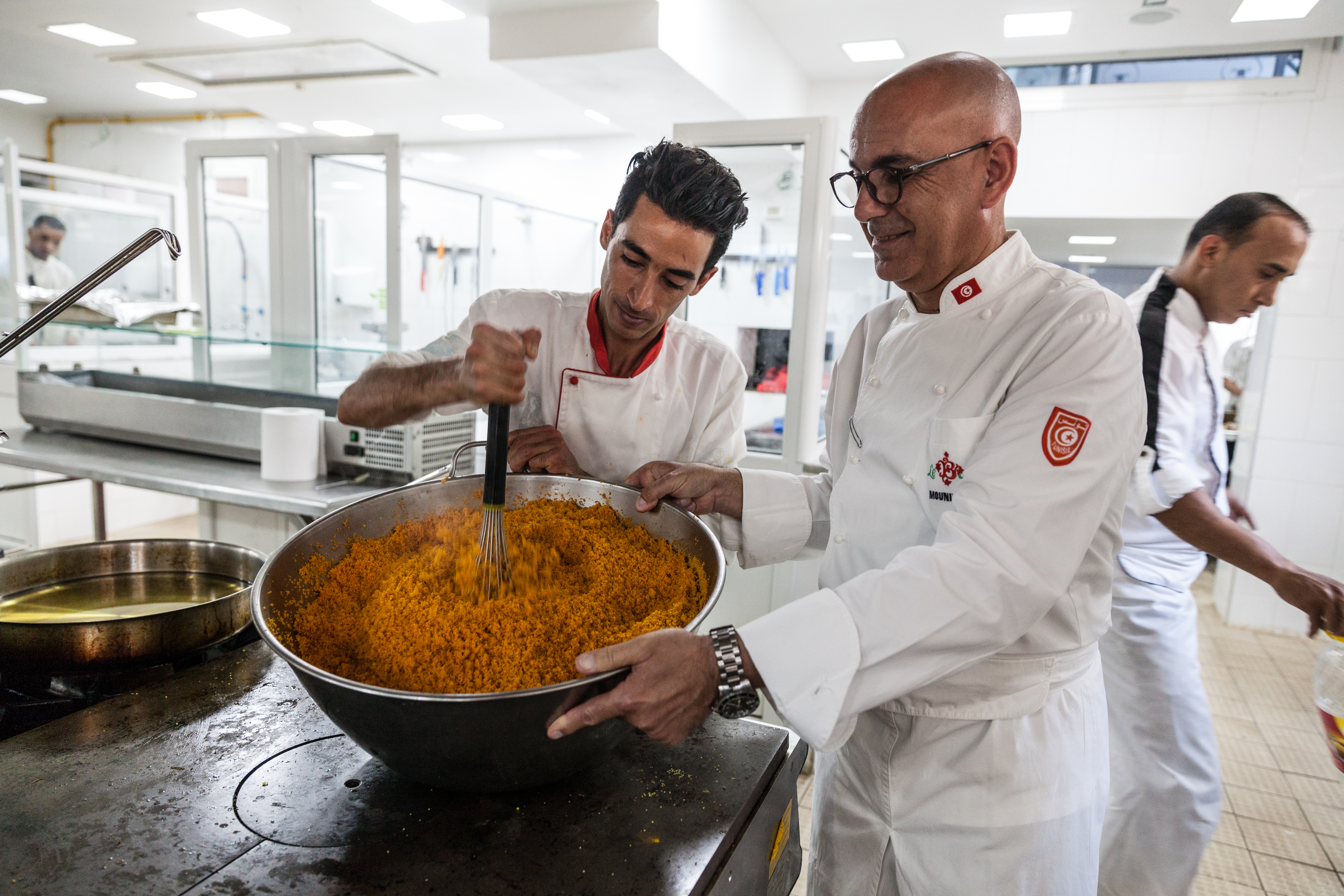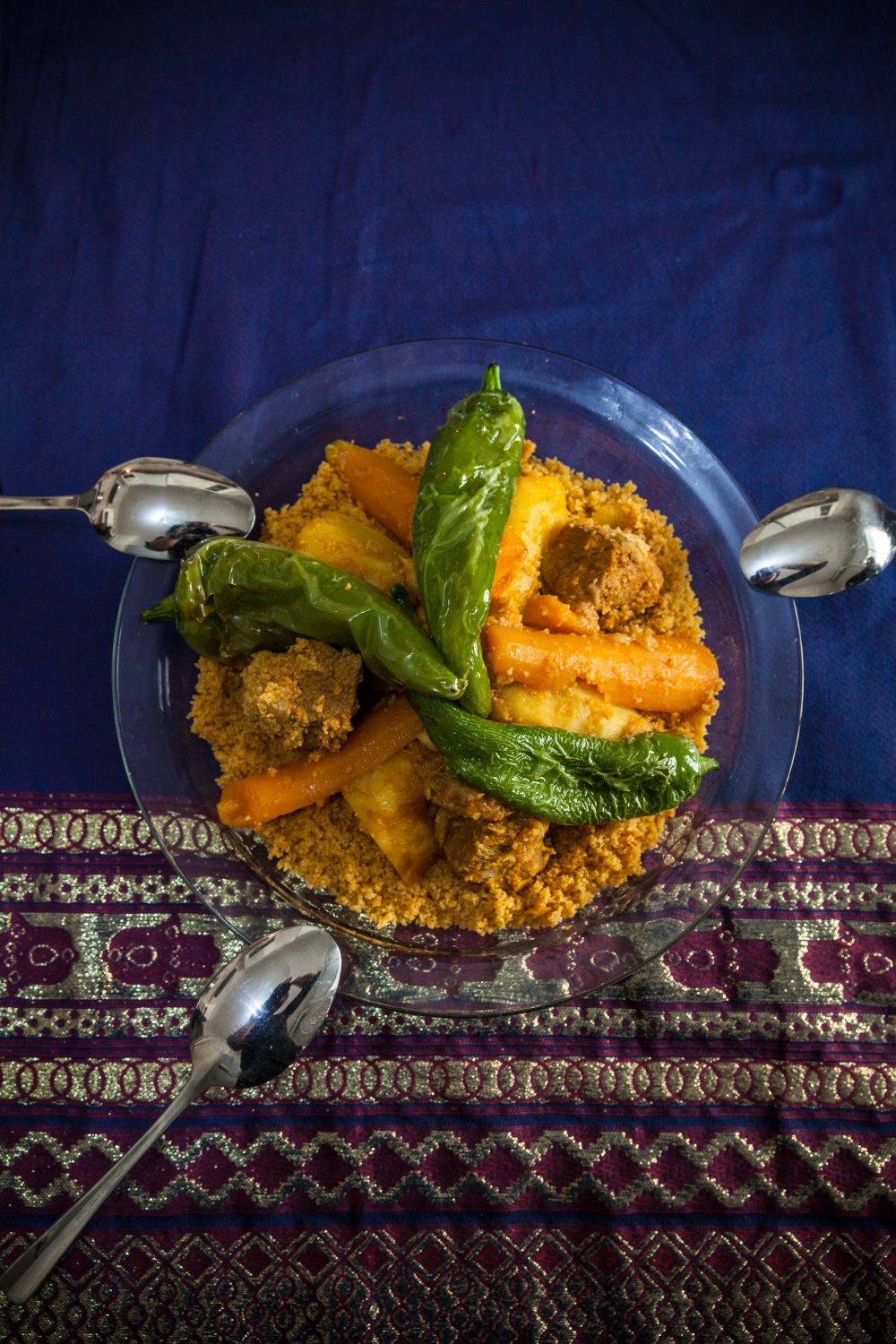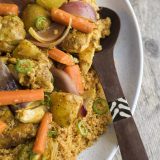In Tunisia, couscous is a verb—to twist and spin—drawn from the hand motion used to make the tiny pasta granules.
It's an apt metaphor for Cafe du Souk, which spins and twists with bodies and smoke when I wander in at 2 a.m. Tucked into a retired rug shop in a corner of Tunis' sprawling medina—or market—the cafe is a cacophony of rhythm and laughter.
Throngs of young men dance, arms raised and waving slowly to rai, live Arabic folk music with a peppy, repetitive beat. The walls are plastered with centuries of tile mosaics, saturated yellows and blues. At wobbly knee-high tables, water pipes—called chicha here, hookah in other parts of the world—are used to puff a heady, fruity smoke flamed by bright red coals.
Above, where there should be ceiling, tan cloth billows upward, drawing the eye to openness. Stars peer in. Tall glasses of lemonade and short mugs of mint tea crowd the tables below. Fresh almonds, chewy, rich and raw, float in them both.

Food—and life—in Tunisia are cast in bold strokes, rich with movement and flavor. Both would come to define my experience of couscous, a revered dish at the heart of North African cuisine and my reason for coming.
I've arrived during Ramadan, the holy month of the Muslim year, a month marked by sunup-to-sunset fasting followed by daily feasts as darkness descends. At every turn, it is an onslaught of the senses.
Harissa, the fiery local condiment, is spooned glibly. Even at breakfast. Even on days that soar to 115°F, the sun baking the ancient hilltop ruins of Carthage that look down over Tunis. Food markets are a riot of aromas: dates, apricots, herbs and seafood. The soundtrack—a repetitive thumping as teenage boys sit on the brick floor, cracking open fresh almonds with the blunt end of glass soda bottles. Nearby, mounds of intensely syrupy, fried sweets—makroud—are sold by fragrant heaps.
Across a week and many platters of couscous topped with fish, lamb or chicken—in homes, at market stalls, on rooftops with humbling views of mosque domes and latices of market streets—I discover the depth of difference.
In the U.S., we misconstrue couscous as a grain, a soppy, matted and flavorless nodule swamped with boiling water, then too casually tossed into salads and under grilled vegetables. At best, it's forgettable, the taste of languor.

"Most people misunderstand the mixing. You can’t turn and toss couscous enough."
In Tunisia, couscous is vibrant and bright, rich with the juices of meat and vegetables. The specks of pasta are distinct, even—seemingly impossibly—substantial. They are topped with stews at once savory, spicy, earthy and sweet.
My lessons come mostly in the evenings, when the fast is broken with the bite of a single date. Sold in iridescent clusters hung from the awnings of street vendors, even dried, the dates are tender and sweet, like a bursting fresh apricot.
Until that moment, the streets sit empty. But as the sun meets the horizon, they erupt, becoming swirling scrums of people, motorbikes and hawkers grilling meat, frying sweets and plying mbesses, the dense semolina bread of Ramadan.
The meal that follows those dates is a crowded table. Tajine, a dense, baked omelet with chicken and spices. Salata mechouia, a spicy baba ghanoush-like dip of grilled peppers. Chorba frik, a thin, spicy soup of broth, tomatoes and freekeh, a toasted and cracked green wheat. Brik, a triangular fried pastry concealing an egg that oozes when you bite.
And, of course, that couscous. That twisting and spinning. Because movement, it turns out, is essential to good couscous.
Traditionally, couscous was made by hand, a laborious process of slowly rubbing moistened semolina flour in circles through a fine sieve to produce minuscule pellets. Hence the name. Today, most is made by machine.
Watching Amel Cherif prepare couscous at her apartment on the outskirts of Tunis, it's clear that the dump-and-go back-of-the-box instructions most Americans follow will never produce great couscous.
Cherif, a financial manager who learned to cook from her mother, explains that proper couscous is moistened three times, three ways. It is stirred and fluffed three times, three ways. And flavor? More is added at each of these stages.
None of it is difficult, or even time consuming. Just different. And better.
Cherif begins by pouring dry couscous into a large bowl, then drizzles it with olive oil. With her fingers, she stirs and rubs until each piece is coated. She repeats the process with water, adding just enough to lightly moisten the granules.
Next, she prepares the makings of a simple, yet robustly flavored stew. Into a large pot: water, lamb, potatoes, chickpeas, onions, carrots, tomato paste, harissia, turmeric and paprika. As it comes to a boil, steam billows up.
That steam is the second source of moisture, the mechanics of which at first baffle me. Cherif pours the couscous into a steamer basket that sits atop the pot. Its bottom is covered in holes far larger than the couscous, but not a single grain falls out. Credit the water Cherif massaged in. The couscous is moist enough to not move, but not so moist that it will clump.
Covered, the couscous absorbs the flavor and moisture of the stew below it, becoming tender, yet remaining distinct. When the stew is cooked, it's time for more movement. Cherif pours the couscous into a large bowl and begins stirring with a fork.
Actually, tossing is more descriptive. Over and again, separating the granules, fluffing them until no two are attached.
More moisture. More flavor. More movement. Cherif drains the liquid from the stew—a viscous, aromatic red broth—then pours it over the couscous, stirring and fluffing until the liquid disappears into the couscous, absorbed entirely.
The drained stew—robust chunks of carrot, halved tender potatoes, melting chunks of meat and tender chickpeas—are the final flourish, heaped over the couscous. The granules remind me of a perfect risotto—distinct grains that are tender, but not mushy, clinging without clumping. Deeply flavored and rich, but not heavy. The harissa permeates with a bright warmth.
Many meals and many conversations with chefs and home cooks across Tunisia bore out the soundness of Cherif's approach. But I learn a final tip from Mounir El Arem, the chef and owner of one of Tunisia's top restaurants.
During a tour of his kitchen at Restaurant La Baroque in Tunis, I see a massive bowl of cooked couscous, bright orange from harissa. Ten pounds or more, at least. Standing up in it—a giant whisk.
Of course, he explains. It's the perfect tool for tossing, aerating and breaking up couscous.
“Most people misunderstand the mixing,” he explains. “You can't turn and toss couscous enough.”




